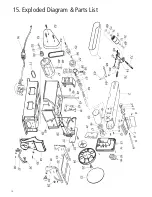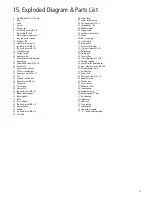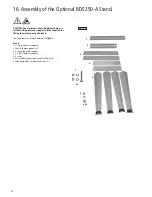
5
2. General Health & Safety Guidance - cont.
Safe Operation
1. Familiarise yourself with the machine
• Machining operations using belt or disc sanders have a history of serious
accidents. Most accidents with sanders are caused by the work piece
being thrown from the sanding surface or by loose clothing or fingers
being caught between the moving parts of the machine.
• The machine is designed for sanding wood and composite board
(plywood, MDF etc.). It should not be used for sanding any
other materials.
2. Before switching the machine ‘ON’:
• Ensure that the table / work support is secure and that any fixings which
allow adjustment are fully tightened.
• Check the condition of the sanding disc / belt for damage or fraying.
Defective discs and belts should be replaced immediately.
• Make sure there are no nails or foreign objects in the part of the work
piece to be sanded.
• Plan your work to avoid throwbacks – the work piece can catch on the
moving sanding surface and may be torn from the hand.
3. Whilst machining:
• Always apply the work piece to the table / work support before it makes
contact with the sanding surface.
• Use extra caution when working with large, very small or irregularly
shaped work pieces.
• When sanding irregularly shaped work pieces, plan your work support so
it will not slip and be pulled from your hands.
• Never use the machine to finish pieces too small to hold by hand.
• Do not apply excessive force to the work piece. Press the work piece
against the sanding surface only hard enough to let it sand without
slowing the machine or binding.
• Keep fingers away from the area between the table / work support and
sanding surface.
• When using a disc sander, always press the work piece against the side
of the disc that is moving down towards the table. Sanding against the
side coming up from under the table could damage the work by making
it “chatter”, or tear the work from the hands and throw it.
• Keep your face and body to one side, out of line of a possible throwback.
4. This machine falls under the scope of the ‘Health & Safety at Work etc.
Act 1974’, and the ‘Provision & Use of Work Equipment Regulations 1998’.
In addition the elimination or control of risks from wood dust is included in
the above regulations and the ‘Control of Substances Hazardous to Health
(COSHH) Regulations 2002’. We recommend that you study and follow
these regulations.
Further guidance is available from The Health & Safety Executive and their
website www.hse.gov.uk.
3. Additional Health & Safety for Belt & Disc Sanders
• Use all machines with extreme care and do not use the machine when
you are tired or under the influence of drugs, alcohol or medication.
24. Use the correct tool for the job
• Do not use the machine for any purpose other than which it
was designed.
• When selecting replacement cutting tools and blades, always ensure that
they are designed to cut the material that you intend to use them for. If
in any doubt seek further advice from the manufacturer.
25. Connect dust extraction equipment
• Always use dust extraction equipment. The dust extractor should be of
suitable size and capacity for the machine that it is connected to and
have a filtration level appropriate to the type of waste being collected.
Refer to the relevant section of the manual for details of the specific dust
extraction requirements for this machine.
• The dust extractor should be switched ‘ON’ before starting the machine
that it is connected to. The dust extractor should be left running for 30
seconds after the last machining operation is complete in order to clear
any residual waste from the machine.
26. Ensure that the machine is correctly guarded
• Never use the machine if any of the standard safety guards and
equipment are removed or damaged.
• Some machines incorporate safety interlocks to prevent the machine
from being used without the guards in place. Never attempt to bypass or
modify the interlocks to allow the machine to be used without the guards
in place.
27. Maintain your machine with care
• This manual gives clear instructions on installation, set up and
operation of the machine and also details any routine and preventative
maintenance that should be performed periodically by the user.
• Remember always to switch off and unplug the machine from the power
supply before carrying out any setting up or maintenance operations.
• Follow any instructions for the maintenance of accessories
and consumables.
• Do not use compressed air to clean the machine. Always use a brush to
dislodge dust in places that are awkward to reach and a dust extractor to
collect the waste.
• Inspect electric cables periodically and, if damaged, have them replaced
by an authorised service facility or qualified electrician.
• Inspect extension cables (if used) periodically and replace if damaged.
28. Keep cutting tools sharp and clean
• Correctly maintained cutting tools are easier to control and less likely
to bind.
• Cutting tools and blades can become hot during use. Take extreme care
when handling them and always allow them to cool before changing,
adjusting or sharpening them.
29. Disconnect the machine from the power supply
• When not in use, before servicing, changing blades etc. always disconnect
the machine from the power supply.
30. Check for damaged parts
• Before each use of the machine, it should be carefully checked to
determine that it will operate properly and perform its
intended function.
• Check for alignment of moving parts, binding of moving parts, breakage
of parts and any other conditions that may affect the operation of
the machine.
• A guard or other part that is damaged should be properly repaired
or replaced by a qualified person unless otherwise indicated in this
instruction manual.
• Do not use the machine if the switch does not turn the machine ‘ON’
and ‘OFF’.
• Have defective switches replaced by a qualified person.
31. Warning!
• The use of any accessory or attachment, other than those recommended
in this instruction manual, or recommended by our Company may present
a risk of personal injury or damage to the machine and invalidation of
the warranty.
32. Have your machine repaired by a qualified person
• This machine complies with the relevant safety rules and standards
appropriate to its type when used in accordance with these instructions
and with all of the standard safety guards and equipment in place. Only
qualified persons using original spare parts should carry out repairs.
Failure to do this may result in considerable danger to the user and
invalidation of warranty.
33. Caution! Motor may become hot during use
• It is normal for motors on some machines to become hot to the touch
during use. Avoid touching the motor directly when in use.






































